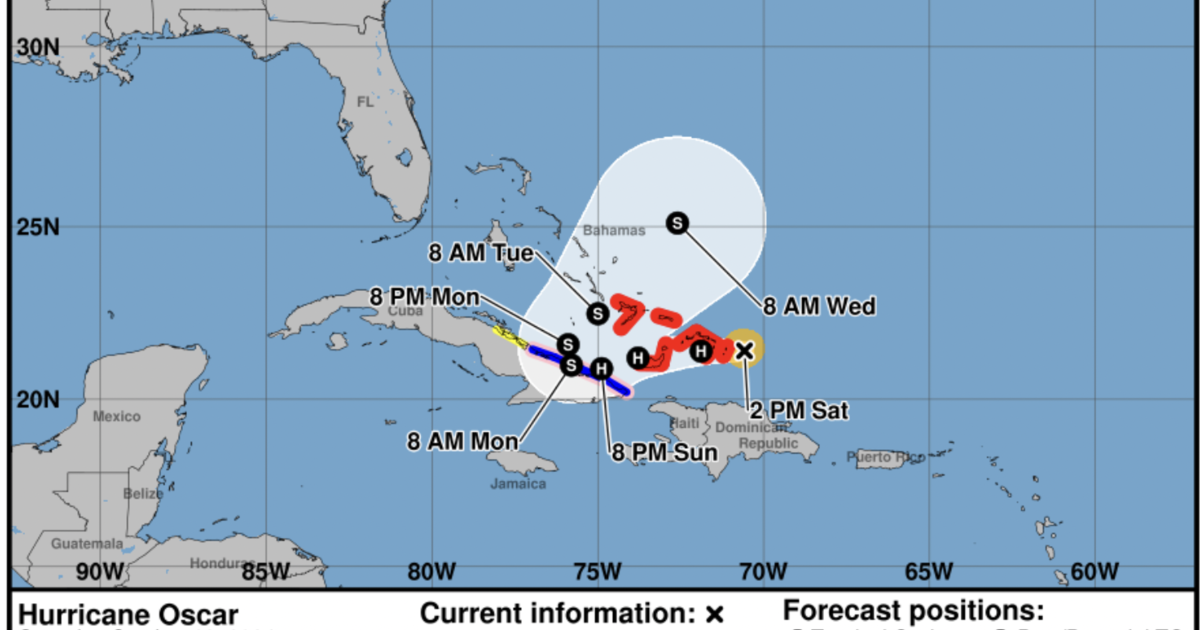Hurricane Oscar, the fifteenth named storm of the 2024 Atlantic hurricane season, rapidly intensified into a hurricane on Saturday, prompting warnings and watches across several Caribbean islands. Initially forming as a tropical storm just east of the Turks and Caicos Islands, Oscar’s intensification took the region by surprise. This unexpected development highlights the unpredictable nature of hurricane formation and the importance of continuous monitoring and preparedness. While characterized as “tiny” by the National Hurricane Center, the storm’s potential for significant impact on the Turks and Caicos Islands, southeastern Bahamas and parts of Cuba should not be underestimated due to its rapidly strengthening winds and potential for heavy rainfall. This event underscores the need for comprehensive hurricane preparedness plans and swift emergency responses. The relatively early appearance of this hurricane and subsequent weather event in the season further emphasizes the crucial need for consistent vigilance. Coupled with recent devastating hurricanes in Florida, the current events provide a timely reminder of the vulnerability of coastal communities to the impacts of powerful storms and the significance of preparation well in advance of hurricane season. It also points to the growing unpredictability of hurricane patterns and underscores the need for continued investment in advanced weather forecasting technologies and preparedness infrastructure.
Hurricane Oscar’s Formation and Intensification
Hurricane Oscar’s swift transition from a tropical storm to a hurricane demonstrates the rapid intensification potential of Atlantic storms. The storm’s unexpectedly quick development underscores the difficulties in accurate prediction of hurricane strength and trajectory.
Rapid Intensification and Trajectory
Oscar formed east of the Turks and Caicos Islands before rapidly gaining strength. The National Hurricane Center monitored its progress closely, issuing warnings and watches as the storm’s path became clearer. The rapid intensification posed challenges for predicting its landfall location and the intensity of its impacts, highlighting the dynamic and unpredictable nature of hurricanes.
Hurricane Warnings and Watches
The Bahamian government issued a hurricane warning for the Turks and Caicos Islands and southeastern Bahamas, urging immediate preparation. This rapid response reflects the potential danger presented by the unexpected strength and trajectory of the storm, prioritizing citizen safety through quick action and information. Cuba also issued a hurricane watch for several provinces, signaling a growing concern about Oscar’s potential for landfall or significant near-shore effects.
Impacts and Projected Path of Hurricane Oscar
Hurricane Oscar’s projected path included heavy rainfall across affected areas. This could lead to various challenges, from localized flooding to potential damage to infrastructure.
Heavy Rainfall and Potential Flooding
The National Hurricane Center predicted significant rainfall across the Turks and Caicos Islands, southeastern Bahamas, and parts of eastern Cuba, indicating a significant flood threat in vulnerable areas. The volume of precipitation can overwhelm drainage systems, leading to flash flooding and prolonged inundation in low-lying areas.
Wind Speeds and Storm Surge
The maximum sustained winds recorded during the height of the storm exceeded 80 mph, a strength capable of producing considerable damage, and higher gusts would have caused more serious impact to buildings and property. Coastal regions were particularly threatened with a possible storm surge which would amplify the power of the already strong winds, increasing destruction and damage. The potential for storm surges presented a direct and immediate threat to coastal structures and populations.
Comparison with Other Recent Hurricanes
Hurricane Oscar is not an isolated incident; recent hurricane activity has brought considerable challenges and devastation to several regions. Its impact should be examined within the context of previous storms such as Hurricane Helene and Milton in Florida.
Florida’s Recent Hurricane Experiences
Florida’s Gulf Coast has suffered considerable impact with consecutive hurricanes in quick succession. This illustrates that multiple storms can lead to compounding consequences. This compounded destruction puts a severe stress on already compromised infrastructure and limited response capabilities in areas affected.
The Broader Atlantic Hurricane Season
The early formation of Hurricane Oscar and the subsequent arrival of several significant storms during the year raises concern that perhaps 2024 has turned out to be an atypically active Atlantic hurricane season, despite NOAA projections earlier.
Take Away Points
- Hurricane Oscar’s rapid intensification highlights the unpredictable nature of hurricane formation and the importance of continuous monitoring.
- The warnings and watches issued underscore the necessity for prompt responses and preparedness plans.
- The potential for heavy rainfall and storm surge necessitates proactive flood prevention and mitigation measures.
- The back-to-back hurricanes highlight the vulnerability of coastal communities and the importance of resilient infrastructure.
- The frequency and intensity of recent hurricanes prompt ongoing reassessment of forecasting methods and preparedness strategies.




